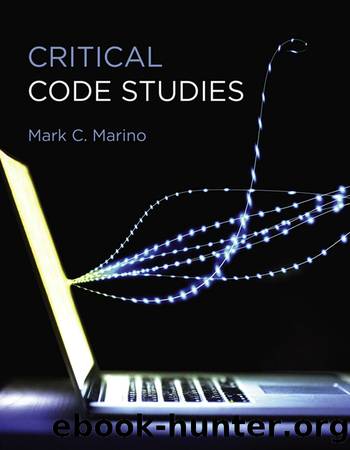Critical Code Studies by Marino Mark C.;

Author:Marino, Mark C.; [Marino, Mark]
Language: eng
Format: epub
Tags: computer source code; algorithms; programming; technoculture; software studies; platform studies; digital humanities; philosophy; media archaeology; ethics; cyberculture; digital literature; hacktavism; computer history; programming languages; poetry generators; electronic literature; digital poetry; climate change; natural language programming; post colonialism; feminism; media studies; new media; algorithmic accountability; history of computing; science and technology studies; hacktavism; software art; immigration; electronic voting; programming languages; COBOL; FLOW-MATIC; Java; J2ME; Python; JavaScript; IDL; C; LISP; raytracers; computer graphics; philosophy; ELIZA; Joseph Weizenbaum; Donald Knuth; Literate Programming; close reading; interpretation; cultural studies; Friedrich Kittler; Grace Hopper; mobile phone applications; apps; programming style programming architecture; conceptual poetry; conceptual writing; poetry; border politics; rhetoric; feminism; transgender
Publisher: MIT Press
Published: 2020-02-14T00:00:00+00:00
Released in 1958, FLOW-MATIC was one of the languages the group used as a model, and it clearly informed these specifications (Marcotty, Sammet, and Holberton 1981, 202). FLOW-MATIC appeared to be “easier to use” and made use of twenty keywords of “simple English language.” However, even for Sammet, FLOW-MATIC represented a bridge too far in the efforts to offer a crutch to those who could not read programming languages. She went on to write, “Perhaps the only disadvantage that accrued from the experience [of developing FLOW-MATIC] was what can be defined as bending over backwards to provide English-like language. In other words, the Remington Rand people felt that no businessman or person concerned with business data processing was really interested in writing symbolic formulas and that if he actually wanted to compute. ... he would prefer to write it as a series of individual statements” (Sammet 1969, 323–324).
Perhaps the clearest modern-day heir to this project (other than COBOL) is the spreadsheet. Considering the vast volume of formulas regularly programmed into spreadsheets today, business has become computational in a way that might even have been inconceivable then. In any event, FLOW-MATIC was a language born out of the frustration of trying to teach managers and other supervisors these daunting new symbolic forms. It stands as a memorial to efforts to make programming languages more readable on the surface level, even when their symbols obscure some of the flow of the program itself.
Download
This site does not store any files on its server. We only index and link to content provided by other sites. Please contact the content providers to delete copyright contents if any and email us, we'll remove relevant links or contents immediately.
Cecilia; Or, Memoirs of an Heiress — Volume 1 by Fanny Burney(32021)
Cecilia; Or, Memoirs of an Heiress — Volume 3 by Fanny Burney(31436)
Cecilia; Or, Memoirs of an Heiress — Volume 2 by Fanny Burney(31380)
The Great Music City by Andrea Baker(30637)
We're Going to Need More Wine by Gabrielle Union(18604)
All the Missing Girls by Megan Miranda(14575)
Pimp by Iceberg Slim(13715)
Bombshells: Glamour Girls of a Lifetime by Sullivan Steve(13663)
Fifty Shades Freed by E L James(12885)
Talking to Strangers by Malcolm Gladwell(12812)
Norse Mythology by Gaiman Neil(12778)
For the Love of Europe by Rick Steves(11330)
Crazy Rich Asians by Kevin Kwan(8859)
Mindhunter: Inside the FBI's Elite Serial Crime Unit by John E. Douglas & Mark Olshaker(8662)
The Lost Art of Listening by Michael P. Nichols(7124)
Enlightenment Now: The Case for Reason, Science, Humanism, and Progress by Steven Pinker(6851)
The Four Agreements by Don Miguel Ruiz(6281)
Bad Blood by John Carreyrou(6251)
Weapons of Math Destruction by Cathy O'Neil(5798)
